Thermal-Assisted Laser Fabrication of Broadband Ultralow Reflectance Surface by Combining Marangoni Flow with In Situ Deposition
Abstract
:1. Introduction
2. Experimental
2.1. Materials and Methods
2.2. Characterization and Measurement
3. Results and Discussion
3.1. Marangoni Flow and In Situ Deposition
3.2. Preparation of Multi-Scale Microcolumn Structure
3.3. Thermal-Assisted Strategy
3.4. Model and Application
4. Conclusions
Author Contributions
Funding
Institutional Review Board Statement
Informed Consent Statement
Data Availability Statement
Conflicts of Interest
References
- Xie, Z.T.; Wang, H.; Li, M.; Tian, Y.; Deng, Q.Y.; Chen, R.; Zhu, X.; Liao, Q. Photothermal trap with multi-scale micro-nano hierarchical structure enhances light absorption and promote photothermal anti-icing/deicing. Chem. Eng. J. 2022, 435, 135025. [Google Scholar] [CrossRef]
- Sharshir, S.W.; Rozza, M.A.; Joseph, A.; Kandeal, A.W.; Tareemi, A.A.; Abou-Taleb, F.; Kabeel, A.E. A new trapezoidal pyramid solar still design with multi thermal enhancers. Appl. Therm. Eng. 2022, 213, 118699. [Google Scholar] [CrossRef]
- Sheikholeslami, M.; Jafaryar, M.; Gerdroodbary, M.B.; Alavi, A.H. Influence of novel turbulator on efficiency of solar collector system. Environ. Technol. Innov. 2022, 26. [Google Scholar] [CrossRef]
- Hosenuzzaman, M.; Rahim, N.A.; Selvaraj, J.; Hasanuzzaman, M.; Malek, A.; Nahar, A. Global prospects, progress, policies, and environmental impact of solar photovoltaic power generation. Renew. Sustain. Energy Rev. 2015, 41, 284–297. [Google Scholar] [CrossRef]
- Wang, Y.; Liu, P.; Vogelbacher, F.; Li, M. Bioinspired multiscale optical structures towards efficient light management in optoelectronic devices. Mater. Today Nano 2022, 19, 100225. [Google Scholar] [CrossRef]
- Guo, C.F.; Sun, T.Y.; Cao, F.; Liu, Q.; Ren, Z.F. Metallic nanostructures for light trapping in energy-harvesting devices. Light-Sci. Appl. 2014, 3, e161. [Google Scholar] [CrossRef] [Green Version]
- Hajian, H.; Rukhlenko, I.D.; Hanson, G.W.; Ozbay, E. Anisotropic absorber and tunable source of MIR radiation based on a black phosphorus-SiC metasurface. Photonics Nanostructures-Fundam. Appl. 2022, 50, 101020. [Google Scholar] [CrossRef]
- Kim, D.G.; Choi, J.H.; Choi, D.K.; Kim, S.W. Highly Bendable and Durable Transparent Electromagnetic Interference Shielding Film Prepared by Wet Sintering of Silver Nanowires. Acs Appl. Mater. Interfaces 2018, 10, 29730–29740. [Google Scholar] [CrossRef]
- Qin, Y.S.; Zhang, M.J.; Guan, Y.; Huang, X.G. Laser absorption and infrared stealth properties of Al/ATO composites. Ceram. Int. 2019, 45, 14312–14315. [Google Scholar] [CrossRef]
- Kim, J.; Han, K.; Hahn, J.W. Selective dual-band metamaterial perfect absorber for infrared stealth technology. Sci. Rep. 2017, 7, 6740. [Google Scholar] [CrossRef]
- Wang, H.R.; Zhang, F.; Wang, C.; Duan, J.A. Broadband antireflective subwavelength structures for infrared detection. Opt. Laser Technol. 2022, 149, 107931. [Google Scholar] [CrossRef]
- Zhang, Y.; Gao, Y.D.; Yu, D.S.; Zhou, J.P.; Sun, D.Q. Preparation of high-strength TC4/304 dissimilar joint with TA2/304 composite interlayer by a dual-pass laser. Opt. Laser Technol. 2022, 154, 108298. [Google Scholar] [CrossRef]
- Venkatesh, S.; Joy, N.; Mageshwaran, G.; Durairaj, R.B.; Reddy, B.S.; Reddy, G.P. Investigation on the electrochemical characteristics of Ti-6Al-4 V weldment. In Proceedings of the 3rd International Conference on Frontiers in Automobile and Mechanical Engineering (FAME), Chennai, India, 2–4 April 2020; pp. 3727–3731. [Google Scholar]
- Raut, H.K.; Ganesh, V.A.; Nair, A.S.; Ramakrishna, S. Anti-reflective coatings: A critical, in-depth review. Energy Environ. Sci. 2011, 4, 3779–3804. [Google Scholar] [CrossRef]
- Han, Z.W.; Jiao, Z.B.; Niu, S.C.; Ren, L.Q. Ascendant bioinspired antireflective materials: Opportunities and challenges coexist. Prog. Mater. Sci. 2019, 103, 1–68. [Google Scholar] [CrossRef]
- Xiong, J.; Das, S.N.; Shin, B.; Kar, J.P.; Choi, J.H.; Myoung, J.M. Biomimetic hierarchical ZnO structure with superhydrophobic and antireflective properties. J. Colloid Interface Sci. 2010, 350, 344–347. [Google Scholar] [CrossRef]
- Xin, G.Q.; Wu, C.Y.; Cao, H.Y.; Liu, W.N.; Li, B.; Huang, Y.; Rong, Y.M.; Zhang, G.J. Superhydrophobic TC4 alloy surface fabricated by laser micro-scanning to reduce adhesion and drag resistance. Surf. Coat. Technol. 2020, 391, 125707. [Google Scholar] [CrossRef]
- Wang, H.P.; Guan, Y.C.; Zheng, H.Y.; Hong, M.H. Controllable fabrication of metallic micro/nano hybrid structuring surface for antireflection by picosecond laser direct writing. Appl. Surf. Sci. 2019, 471, 347–354. [Google Scholar] [CrossRef]
- Su, Y.; Wang, S.Q.; Yao, D.W.; Fu, Y.; Zang, H.W.; Xu, H.L.; Polynkin, P. Stand-off fabrication of irregularly shaped, multi-functional hydrophobic and antireflective metal surfaces using femtosecond laser filaments in air. Appl. Surf. Sci. 2019, 494, 1007–1012. [Google Scholar] [CrossRef]
- Yan, T.Y.; Ji, L.F.; Hong, M.H. Backside wet etching of sapphire substrate by laser-induced carbothermal reduction. Opt. Laser Technol. 2022, 149, 107900. [Google Scholar] [CrossRef]
- Li, X.; Li, M.; Liu, H.J. Effective strategy to achieve a metal surface with ultralow reflectivity by femtosecond laser fabrication. Chin. Opt. Lett. 2021, 19, 051401. [Google Scholar] [CrossRef]
- Li, J.R.; Xu, J.K.; Lian, Z.X.; Yu, Z.J.; Yu, H.D. Fabrication of antireflection surfaces with superhydrophobic property for titanium alloy by nanosecond laser irradiation. Opt. Laser Technol. 2020, 126, 106129. [Google Scholar] [CrossRef]
- Fan, P.X.; Bai, B.F.; Zhong, M.L.; Zhang, H.J.; Long, J.Y.; Han, J.P.; Wang, W.Q.; Jin, G.F. General Strategy toward Dual-Scale-Controlled Metallic Micro-Nano Hybrid Structures with Ultralow Reflectance. Acs Nano 2017, 11, 7401–7408. [Google Scholar] [CrossRef]
- Du, M.D.; Sun, Q.Q.; Jiao, W.; Shen, L.F.; Chen, X.; Xiao, J.F.; Xu, J.F. Fabrication of Antireflection Micro/Nanostructures on the Surface of Aluminum Alloy by Femtosecond Laser. Micromachines 2021, 12, 1406. [Google Scholar] [CrossRef] [PubMed]
- Lou, R.; Zhang, G.D.; Li, G.Y.; Li, X.L.; Liu, Q.; Cheng, G.H. Design and Fabrication of Dual-Scale Broadband Antireflective Structures on Metal Surfaces by Using Nanosecond and Femtosecond Lasers. Micromachines 2020, 11, 20. [Google Scholar] [CrossRef] [PubMed] [Green Version]
- Cui, J.; Xia, H.Y.; Su, C.W.; Yang, G.F. Research on ice suppression performance of titanium alloy surface induced by nanosecond laser. J. Mater. Res. Technol.-JmrT 2022, 19, 1578–1589. [Google Scholar] [CrossRef]
- Yong, J.L.; Chen, F.; Yang, Q.; Zhang, D.S.; Farooq, U.; Du, G.Q.; Hou, X. Bioinspired underwater superoleophobic surface with ultralow oil-adhesion achieved by femtosecond laser microfabrication. J. Mater. Chem. A 2014, 2, 8790–8795. [Google Scholar] [CrossRef]
- Chen, Z.K.; Zhou, R.; Yan, H.P.; Lin, Y.H.; Huang, W.P.; Yuan, G.F.; Cui, J.Q. Bioinspired robust top-perforated micro-conical array of TC4 surface fabricated by pulsed laser ablation for enhanced anti-icing property. J. Mater. Sci. 2022, 57, 8890–8903. [Google Scholar] [CrossRef]
- Guo, C.F.; Zhang, M.J.; Hu, J. Fabrication of hierarchical structures on titanium alloy surfaces by nanosecond laser for wettability modification. Opt. Laser Technol. 2022, 148, 107728. [Google Scholar] [CrossRef]
- Yin, J.B.; Yan, H.P.; Dunzhu, G.; Wang, R.; Cao, S.Z.; Zhou, R.; Li, Y.Z. General Strategy toward Laser Single-Step Generation of Multiscale Anti-Reflection Structures by Marangoni Effect. Micromachines 2022, 13, 1491. [Google Scholar] [CrossRef]
- Zhang, D.S.; Sugioka, K. Hierarchical microstructures with high spatial frequency laser induced periodic surface structures possessing different orientations created by femtosecond laser ablation of silicon in liquids. Opto-Electron. Adv. 2019, 2, 190002. [Google Scholar] [CrossRef]
- Yang, H.; Gun, X.Y.; Pang, G.H.; Zheng, Z.X.; Li, C.B.; Yang, C.; Wang, M.; Xu, K.C. Femtosecond laser patterned superhydrophobic/hydrophobic SERS sensors for rapid positioning ultratrace detection. Optics Express 2021, 29, 16904–16913. [Google Scholar] [CrossRef] [PubMed]
- Yang, H.; Xu, K.C.; Xu, C.W.; Fan, D.Y.; Cao, Y.; Xue, W.; Pang, J.H. Femtosecond Laser Fabricated Elastomeric Superhydrophobic Surface with Stretching-Enhanced Water Repellency. Nanoscale Res. Lett. 2019, 14, 333. [Google Scholar] [CrossRef] [PubMed]
- Liu, X.Q.; Bai, B.F.; Chen, Q.D.; Sun, H.B. Etching-assisted femtosecond laser modification of hard materials. Opto-Electron. Adv. 2019, 2, 190021. [Google Scholar] [CrossRef] [Green Version]
- Yang, J.; Luo, F.F.; Kao, T.S.; Li, X.; Ho, G.W.; Teng, J.H.; Luo, X.G.; Hong, M.H. Design and fabrication of broadband ultralow reflectivity black Si surfaces by laser micro/nanoprocessing. Light-Sci. Appl. 2014, 3, e185. [Google Scholar] [CrossRef]
- Yuan, J.D.; Liang, L.; Lin, G.Z. Study on processing characteristics and mechanisms of thermally assisted laser materials processing. Surf. Coat. Technol. 2019, 378, 124946. [Google Scholar] [CrossRef]
- Fan, P.X.; Bai, B.F.; Long, J.Y.; Jiang, D.F.; Jin, G.F.; Zhang, H.J.; Zhong, M.L. Broadband High-Performance Infrared Antireflection Nanowires Facilely Grown on Ultrafast Laser Structured Cu Surface. Nano Lett. 2015, 15, 5988–5994. [Google Scholar] [CrossRef]

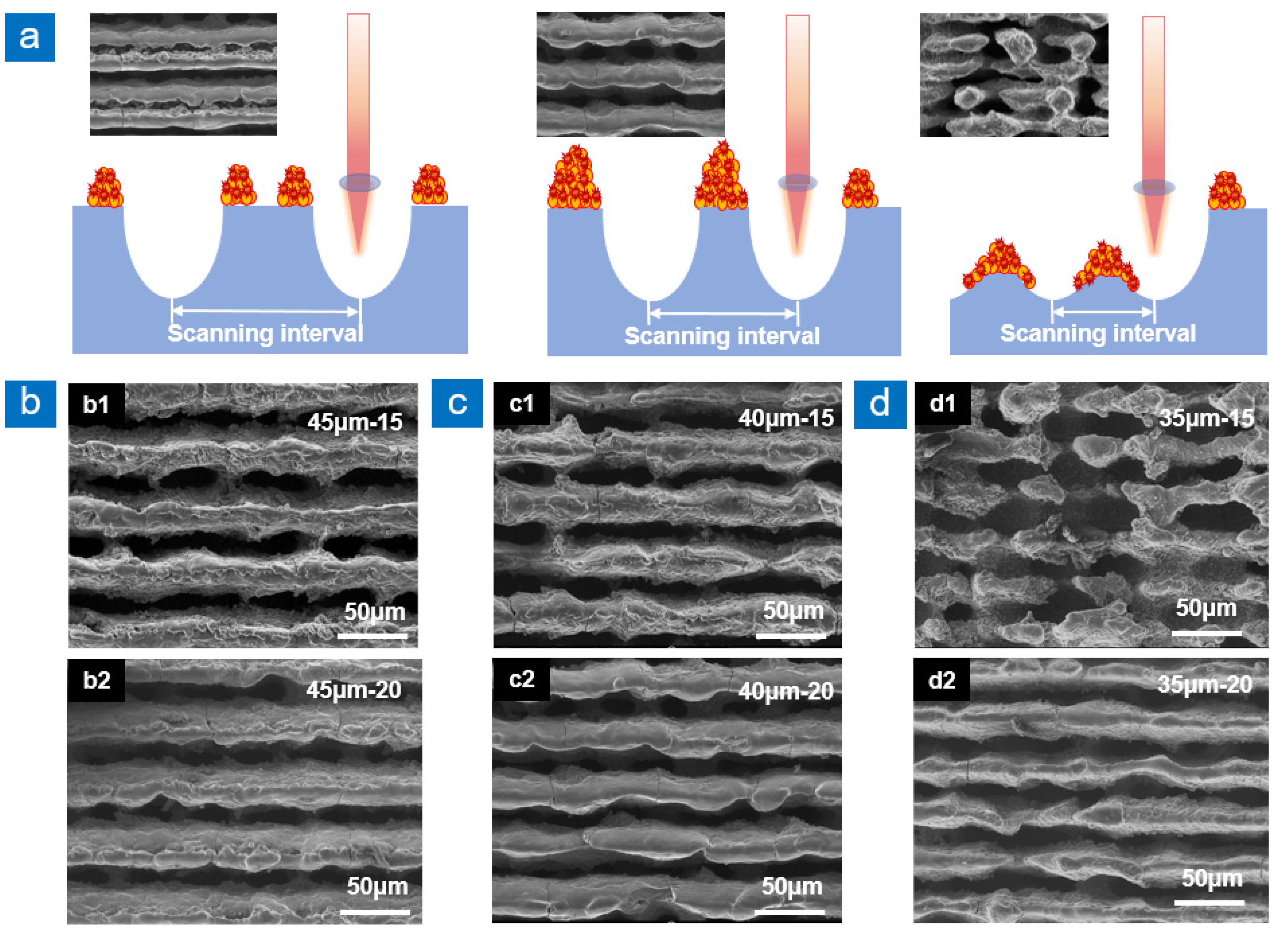
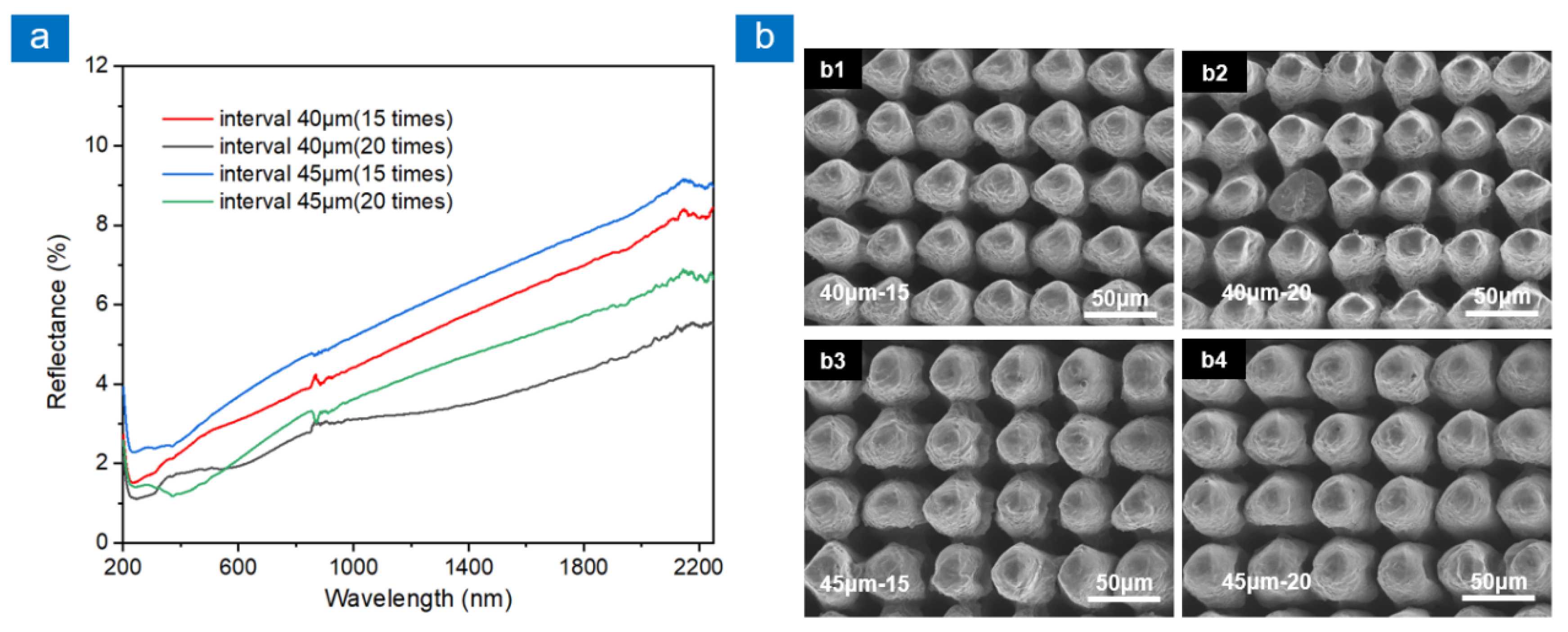
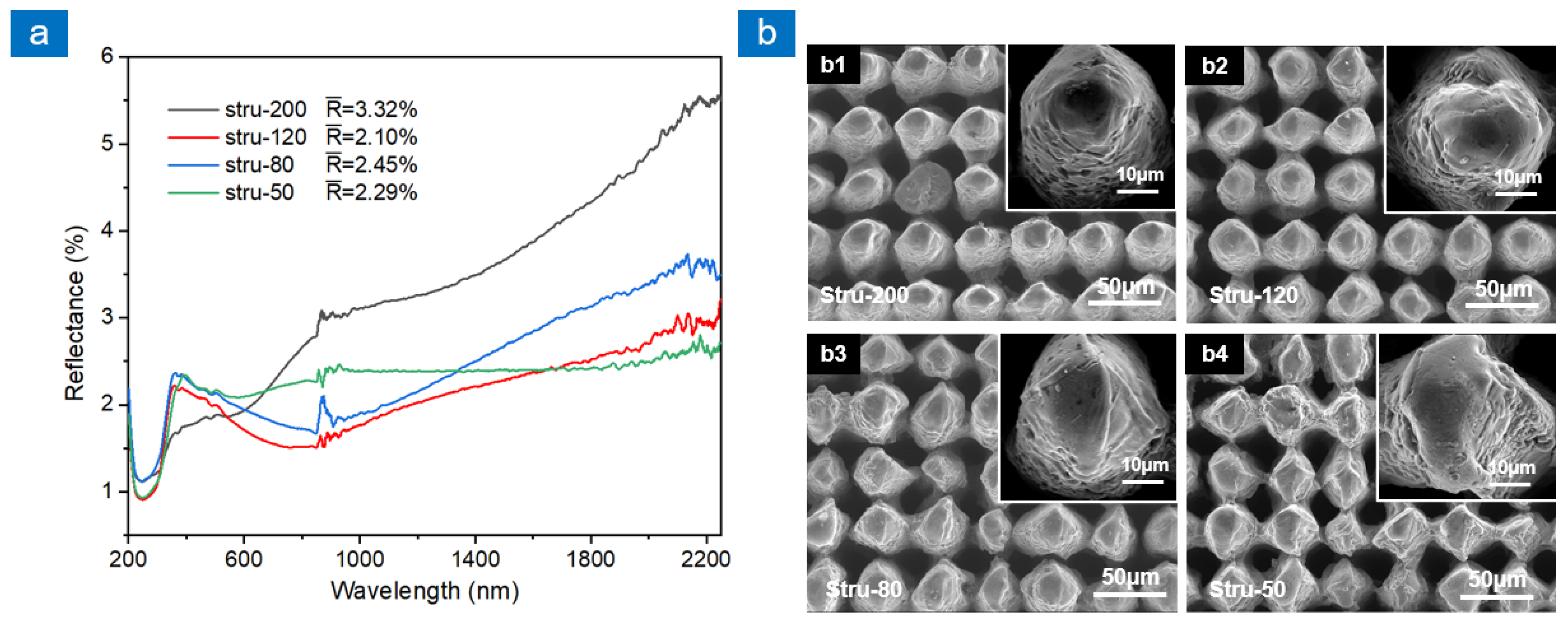
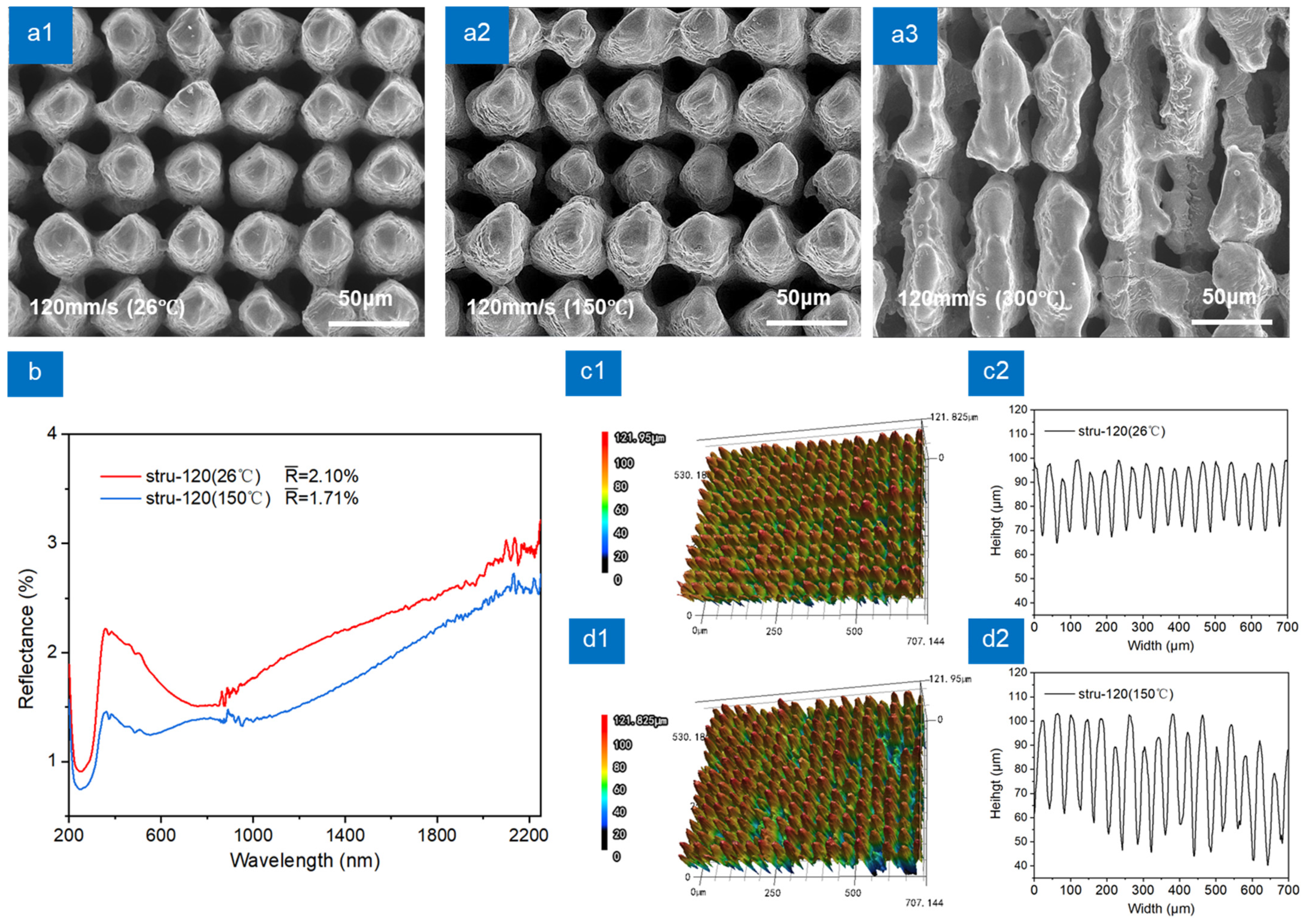
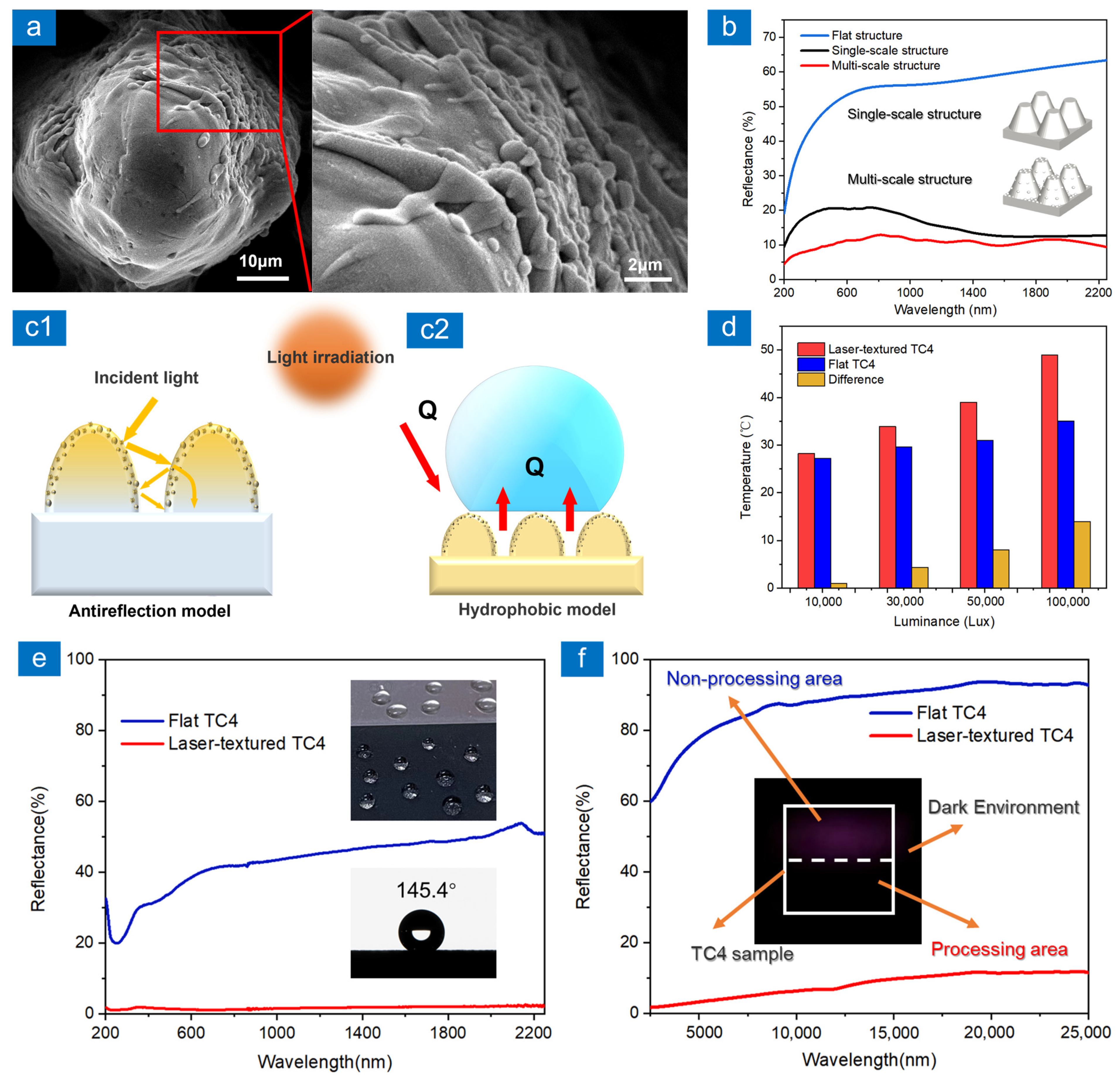
| Sample | Ti (%) | O (%) |
|---|---|---|
| Stru-120 (26 °C) | 38.23 | 61.77 |
| Stru-120 (150 °C) | 32.14 | 67.86 |
Disclaimer/Publisher’s Note: The statements, opinions and data contained in all publications are solely those of the individual author(s) and contributor(s) and not of MDPI and/or the editor(s). MDPI and/or the editor(s) disclaim responsibility for any injury to people or property resulting from any ideas, methods, instructions or products referred to in the content. |
© 2023 by the authors. Licensee MDPI, Basel, Switzerland. This article is an open access article distributed under the terms and conditions of the Creative Commons Attribution (CC BY) license (https://creativecommons.org/licenses/by/4.0/).
Share and Cite
Yin, J.; Yan, H.; Zhou, R.; Li, Y.; He, A. Thermal-Assisted Laser Fabrication of Broadband Ultralow Reflectance Surface by Combining Marangoni Flow with In Situ Deposition. Nanomaterials 2023, 13, 480. https://doi.org/10.3390/nano13030480
Yin J, Yan H, Zhou R, Li Y, He A. Thermal-Assisted Laser Fabrication of Broadband Ultralow Reflectance Surface by Combining Marangoni Flow with In Situ Deposition. Nanomaterials. 2023; 13(3):480. https://doi.org/10.3390/nano13030480
Chicago/Turabian StyleYin, Jingbo, Huangping Yan, Rui Zhou, Yuanzhe Li, and Anna He. 2023. "Thermal-Assisted Laser Fabrication of Broadband Ultralow Reflectance Surface by Combining Marangoni Flow with In Situ Deposition" Nanomaterials 13, no. 3: 480. https://doi.org/10.3390/nano13030480
APA StyleYin, J., Yan, H., Zhou, R., Li, Y., & He, A. (2023). Thermal-Assisted Laser Fabrication of Broadband Ultralow Reflectance Surface by Combining Marangoni Flow with In Situ Deposition. Nanomaterials, 13(3), 480. https://doi.org/10.3390/nano13030480







